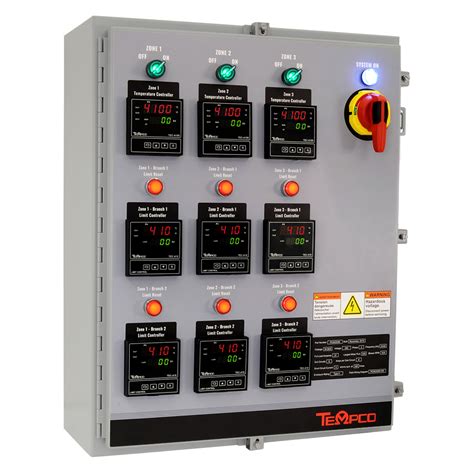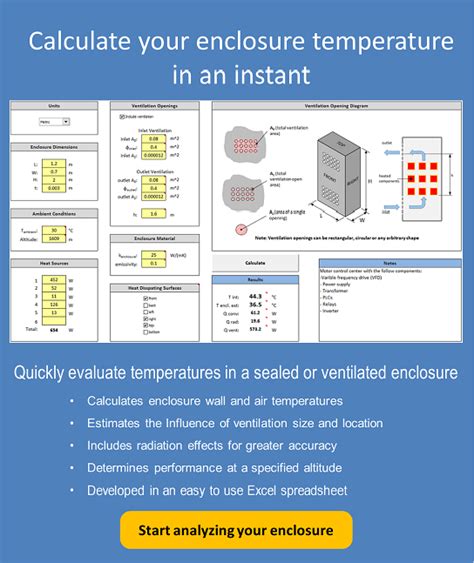how to calculate forced convection in electrical enclosures Early architecture to detailed design - assessing cooling options and performance. Best practices for passive cooling, forced convection fan cooling through to sealed systems. Fan selection, venting, use of plenums, phase . Discover the pros and cons of aluminum and fiberglass window screen mesh to determine which is better. Make an informed decision for your window screens.
0 · thermal control enclosure dimensions
1 · sealed enclosure temperature rise calculator
2 · sealed enclosure temperature calculation
3 · enclosure thermal system sizing
4 · enclosure temperature rise formula
5 · enclosure heating system sizes
6 · enclosure heating requirements
7 · control enclosure heating requirements
EVERY single time you have exposed wire you must have a junction box, there are zero exceptions. I would advice addressing this wiring issue either yourself or by a licensed electrician sooner rather than later, or risk a fire. Home Depot is usually the cheapest for boxes.
Learn how to run heat transfer simulations to investigate forced convection cooling in an electronic enclosure, all by running your simulations from a web br.The equations used to calculate the thermal resistance associated with the convective heat transfer from the air inside the enclosure to the walls of the enclosure are as follows: Convection to Internal Bottom SurfaceEarly architecture to detailed design - assessing cooling options and performance. Best practices for passive cooling, forced convection fan cooling through to sealed systems. Fan selection, venting, use of plenums, phase .The next step up from natural convection is forced convection cooling. The basic cooling mechanism is the same: cooler air from outside the enclosure. passes through the enclosure .
How to calculate the temperature in a ventilated electronics enclosure. Electrical and electronic components are sometimes housed in enclosures with ventilation openings to allow ambient air into the enclosure to more efficiently cool heat .
Forced Convection Cooling of an Enclosure with Fan and Grille. Introduction. This study simulates the thermal behavior of a computer power supply unit (PSU). Such electronic enclosures typically include cooling devices to avoid electronic .First calculate the surface area of the enclosure and, from the expected heat load and the surface area, determine the heat input power in watts/ft.2 Then the expected temperature rise can be .
Qc Op - displays the cooling performance of the thermoelectric module at the temperature difference requested. The cooling performance shown is at a typical operating point (Iop) set at .The enclosure temperature rise calculator is used to calculate the average internal air temperature of a cuboid enclosure with internal heat generating components cooled via natural convection and radiation.
thermal control enclosure dimensions
Forced air cooling is particularly effective in applications with high heat loads and tight spaces. Natural Convection Cooling. Another popular method of dissipating heat from control cabinet enclosures is natural convection cooling. This . Kooltronic's Enclosure Cooling Calculator is a free, easy-to-use product sizing and selection tool designed to help you find the right thermal management product to match your requirements. Simply enter a few details .hoffman ® mclean ® schroff pentair hoffman ® mclean ® schroff ® hoffman ® mclean ® schroff ® why can temperature variation be a problem? temperature extremes will cause
Natural Convection vs. Forced Convection: Consider the mode of heat dissipation—whether natural convection (air circulation without external aid) or forced convection (using fans or other .
Using the same principle as natural convection, forced convection adds a fan, blower, or compressed air to force the warmed air through the enclosure and out through the upper vent (Ventilation Fan Filter Systems). Air moving devices include Fans and Blowers. Fans are commonly used in enclosures to move the air more quickly than natural convection.

The selected version of the design with perforation in the bottom part Case study #2: Double enclosure for convection. Below is another example of natural convection cooling.natural convection and radiation,therefore internal electronic packages have lower hot spot temperatures with forced air systems. The amount of cooling air flowing through an enclosure determines the temperature rise inside the enclosure due to the heat input. The more air that flows through the enclosure,the lower the temperature rise.Electrical and electronic components are sometimes housed in enclosures with ventilation openings to allow ambient air into the enclosure to more efficiently cool heat generating components. The most common ventilation configuration is to have openings at the top and bottom of the enclosure as shown in figure 1.This Excel spreadsheet calculator will estimate the average internal air temperature and external wall temperature of a ventilated or sealed cuboid enclosure typically used to house electrical or electronic equipment. Empirical heat transfer correlations and a thermal resistance network are used to calculate the results. If a sealed enclosure results in too high of a temperature rise the .
As with natural convection cooling, the ambient air temperature must be lower than the desired enclosure temperature for forced convection to be effective. A typical forced convection system consists of a fan and a grille, with a filter on the intake device and either a filter or louvers on the exhaust device. The filtersSo, cooling methods must be done in panel enclosures to increase the lifetime of devices and maintain the operation under control for a long time. There are many methods to cool a panel like natural convection cooling, forced convection cooling, air conditioning, heat exchangers, vortex cooling, thermoelectric cooling, etc. Out of these, we will discuss air conditioning in this post. This work presents a new parametric correlation for 2D enclosures with forced convection obtained from CFD simulation. The convective heat transfer coefficient of walls for enclosures depends on the geometry of the enclosure and the inlet and outlet openings, the velocity and the air to wall temperature difference. However, current correlations not . Lakshminarasimha N, [3], [2015], Study involves numerical investigation on electrical enclosure with forced convection cooling consist 150W heat power source. Study highlights analytical .
Enclosure manufacturers can provide guidance to users in selecting the proper cooling approaches. The most commonly used cooling methods for enclosures, in order of increasing cost, are natural convection, forced convection (such as fans and blowers) and air conditioning. Natural Convection Cooling Electronics components receive electrical power and generate heat (e.g. resistive losses). The heat load from each component can be defined by assigning an absolute power source in watts. . Thermal Analysis of an .Uses for the Enclosure Temperature Rise Calculator. The enclosure temperature rise calculator is used to calculate the average internal air temperature of a cuboid enclosure with internal heat generating components cooled via natural . This method may keep an enclosure cool, but only works for electrical enclosures placed where the outside air stays consistently colder than the air inside the enclosure. Vents may also require air filters to prevent dust .
The temperature rise inside a sealed cabinet without forced ventilation can be approximated as follows. First calculate the surface area of the enclosure and, from the expected heat load and the surface area, determine the heat input power in . Heat Dissipation in Electrical Enclosures Spec-00488 D Subject to change without notice PH (763 .
Hot spots are commonly occurring thermal phenomena and refer to areas within electrical enclosures that are not cooled by the forced convection. It is impossible to say where hot spots might occur in an enclosure because the layout, heat load of the electrical equipment, size of the enclosure and ambient conditions are unique to each installation.
Here's what you need to know about telecom electrical enclosure cooling. Search. 972.580.0200 or 888.580. . Both NEMA 4 and NEMA 4X enclosures require closed-loop cooling systems rather than fan or forced convection systems. . An online enclosure temperature management calculator can be used to assist in selecting the proper cooling system .Calculating the airflow required to cool an enclosure can be simple. First, calculate the amount of heat energy being generated within the enclosure that needs to be dissipated. Next calculate the required air temperature and establish the altitude. Then from this data the correct airflow for the application can be calculated. One of the elements in this thermal resistance chain is the resistance between the air inside your enclosure and the enclosure's wall. If you place a heatsink inside the enclosure this thermal resistance is replaced by the sum of two new resistances: that between air and heatsink and that between heatsink and enclosure wall.
Help. Move a slider to your specified cooling requirement (Qc) and click the SEARCH button. As you move the slider to the right, multiple product categories may offer suitable standard solutions. How to Calculate Temperature Rise Inside Enclosures. Here’s a simplified set of steps for calculating an electrical enclosure’s temperature rise: First, find the input power, expressed in watts per square foot. Take the amount of heat dissipated within the enclosure in watts and divide it by the enclosure’s surface area in square feet.
4 | FORCED CONVECTION COOLING OF AN ENCLOSURE WITH FAN AND GRILLE where α is the opening ratio of the grille. Figure 2: Head loss coefficient as a function of the opening ratio. The head loss, ΔP (Pa), is given by where ρ is the density (kg/m3), and V 0 is the flow rate (m 3/s). The box, the PCB, the inductor surfaces, and the heat sink fins are configured as thinConvection. Convection is the transfer of heat by the movement of fluids (liquids or gases). It involves the combined effects of conduction and fluid motion. The rate of heat transfer through convection can be calculated using Newton’s Law of Cooling: \( Q = hA(T_s – T_\infty) \) Where: Q is the heat transfer rate (W).The internal temperature of an electrical enclosure is directly related to the heat load inside the enclosure, the ambient temperature and the rate of heat removal. These may be assessed as follows: Internal heat load: The first step is to assess the heat load of the equipment installed inside the enclosure.
how to make a acoustic electric cigar box guitar

how to install standard handy wall electrical box
$19.99
how to calculate forced convection in electrical enclosures|enclosure heating requirements